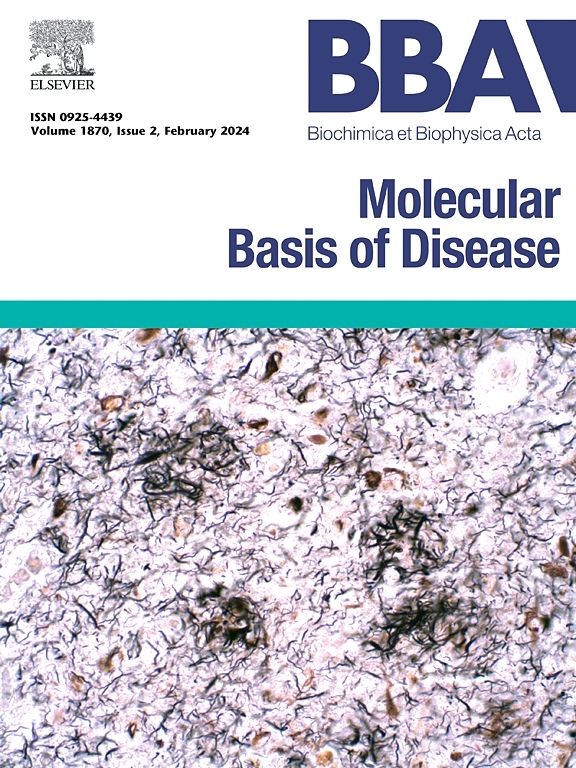The voltage-gated sodium channel β3 subunit modulates C6 glioma cell motility independently of channel activity
IF 4.2
2区 生物学
Q2 BIOCHEMISTRY & MOLECULAR BIOLOGY
Biochimica et biophysica acta. Molecular basis of disease
Pub Date : 2025-04-15
DOI:10.1016/j.bbadis.2025.167844
引用次数: 0
Abstract
Background
Voltage-gated sodium channels (VGSCs) initiate action potentials in nerve and muscle cells and are regulated by auxiliary β subunits. VGSC β subunits are also expressed in some cancer types, suggesting potential functions distinct from their role in electrophysiological excitability. This study investigated the occurrence and functional implications of the VGSC β3 subunit (the product of SCN3B gene) in glioma, focusing on the role of its extracellular immunoglobulin domain (β3 Ig).
Methods
Data mining explored associations between β3 expression and glioma severity at patient, tissue, and single-cell levels. Using C6 glioma cells expressing β3 or β3 without its Ig domain, we examined the effects on cell viability, mobility, and actin-based cell protrusions. A single-chain variable fragment (scFv) antibody targeting the β3 Ig was selected by phage display to interfere with its functions. The interacting proteins with β3 Ig were identified by immunoprecipitation-mass spectrometry.
Results
Data mining revealed negative correlations between β3 expression and glioma severity and aggressiveness. Expression of β3 in C6 cells reduced cell migration and invasion without affecting cell viability. Filopodia were significantly increased while lamellipodia/ruffles were decreased, producing striking cell morphological changes. These effects were abrogated by expression of the β3 subunit lacking the β3 Ig domain or exogenous application of an scFv targeting β3 Ig. Most of the plasma membrane-associated proteins immunoprecipitated with the β3 subunit are known regulators of actin polymerization.
Conclusion
Our data reveals a novel and unexpected role for the VGSC β3 subunit in orchestrating actin organization and negatively regulating cell migration in glioma cells which may potentially explain clinical correlations with glioma severity.

电压门控钠通道β3亚基独立于通道活性调节C6胶质瘤细胞的运动
电压门控钠通道(VGSCs)在神经和肌肉细胞中启动动作电位,并受辅助β亚基调节。VGSC β亚基也在某些癌症类型中表达,表明其潜在功能不同于其在电生理兴奋性中的作用。本研究探讨了VGSC β3亚基(SCN3B基因的产物)在胶质瘤中的发生及其功能意义,重点研究了其细胞外免疫球蛋白结构域(β 3ig)的作用。方法数据挖掘在患者、组织和单细胞水平上探讨β3表达与胶质瘤严重程度的关系。我们使用表达β3或不含其Ig结构域的β3的C6胶质瘤细胞,研究了它们对细胞活力、流动性和基于肌动蛋白的细胞突起的影响。通过噬菌体展示,选择了一种靶向β 3ig的单链可变片段(scFv)抗体,干扰其功能。免疫沉淀-质谱法鉴定与β 3ig相互作用的蛋白。结果β3的表达与胶质瘤的严重程度和侵袭性呈负相关。在C6细胞中表达β3可减少细胞迁移和侵袭,但不影响细胞活力。丝状足显著增加,片足/褶叶显著减少,细胞形态发生显著变化。缺乏β 3ig结构域的β3亚基的表达或外源应用靶向β 3ig的scFv可消除这些影响。大多数与β3亚基免疫沉淀的质膜相关蛋白是已知的肌动蛋白聚合的调节因子。结论我们的数据揭示了VGSC β3亚基在协调肌动蛋白组织和负调控胶质瘤细胞迁移中的一个新的和意想不到的作用,这可能解释了胶质瘤严重程度的临床相关性。
本文章由计算机程序翻译,如有差异,请以英文原文为准。
求助全文
约1分钟内获得全文
求助全文
来源期刊
CiteScore
12.30
自引率
0.00%
发文量
218
审稿时长
32 days
期刊介绍:
BBA Molecular Basis of Disease addresses the biochemistry and molecular genetics of disease processes and models of human disease. This journal covers aspects of aging, cancer, metabolic-, neurological-, and immunological-based disease. Manuscripts focused on using animal models to elucidate biochemical and mechanistic insight in each of these conditions, are particularly encouraged. Manuscripts should emphasize the underlying mechanisms of disease pathways and provide novel contributions to the understanding and/or treatment of these disorders. Highly descriptive and method development submissions may be declined without full review. The submission of uninvited reviews to BBA - Molecular Basis of Disease is strongly discouraged, and any such uninvited review should be accompanied by a coverletter outlining the compelling reasons why the review should be considered.

 求助内容:
求助内容: 应助结果提醒方式:
应助结果提醒方式:


